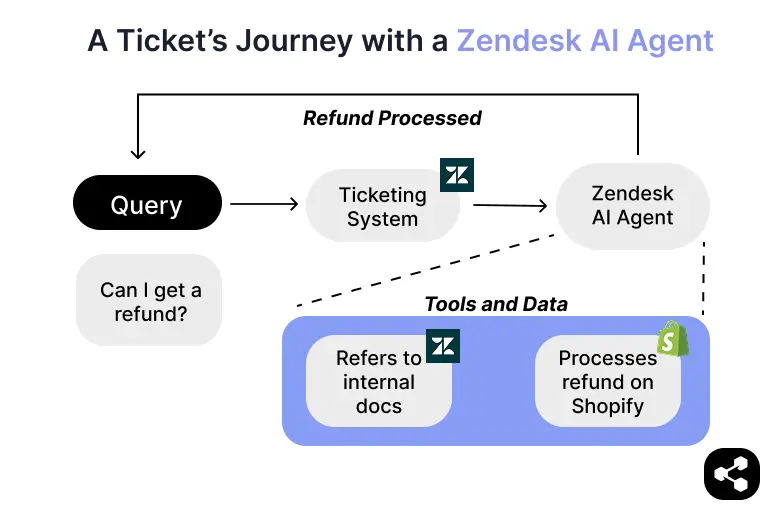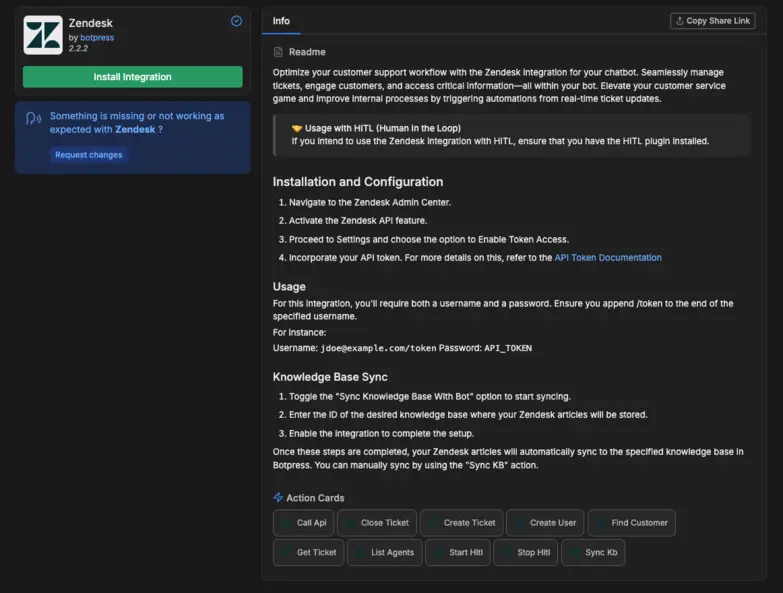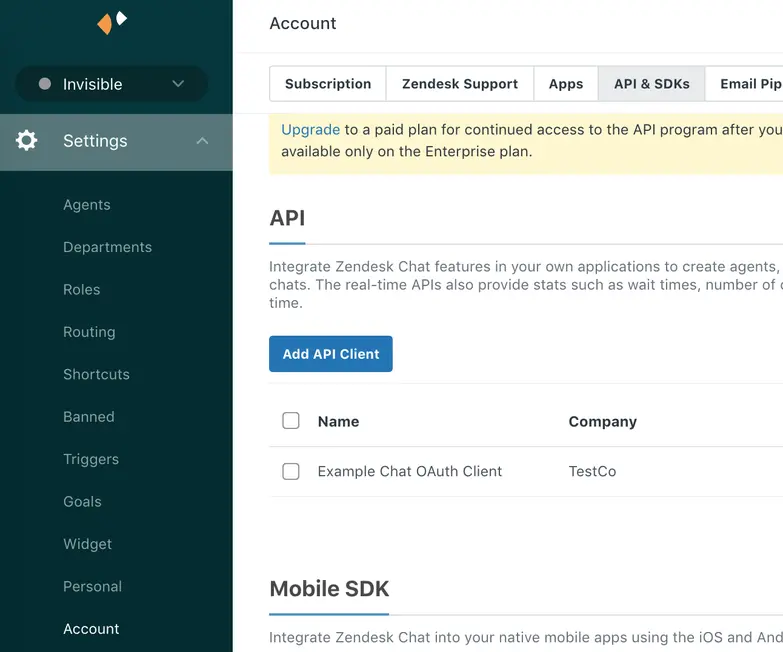- Zendesk AI agents tag, route, and even trigger actions in tools like Stripe or Shopify to fully resolve tickets.
- Zendesk AI agents run the same logic across chat, email, WhatsApp, and more—no rebuilding required.
- While Zendesk’s AI handles basics, platforms like Botpress let you build deeper automations and custom flows for true AI-powered support.
A while back, I worked with a mid-size e-commerce team that lived inside Zendesk. Every ticket told a story — from a frustrated call about a delayed order to someone asking to update their billing information.
The team thrived on Zendesk by ensuring workflows were clean and tight. And while the support agents genuinely cared about resolving issues, the queue continued to grow.
The kicker? About 60% of the tickets were just five repetitive questions
That’s where things changed. By building AI agents directly into Zendesk, we automated those repeat interactions, without disrupting the rest of the support flow.
Within a week, the backlog started shrinking. The new Zendesk AI agent setup took over recurring tickets, letting human agents finally focus on the complex cases that actually needed them.
What is a Zendesk AI agent?
Zendesk AI agents are advanced bots powered by large language models (LLMs) that help handle customer service tasks like answering FAQs to processing refunds.
These AI agents can be built directly inside Zendesk or plugged in from platforms like Botpress or Tidio, depending on how your team wants to build and manage them.
They live inside your Zendesk setup alongside your customer data and company docs, and are built to resolve tickets across channels and languages.
Key Benefits of Using Zendesk AI Agents
Respond to tickets instantly
Able, a personalized health coaching solution built on Botpress, cut over 65% of their customer ticket volume using AI agents.
For RubyLabs, the company behind Able, the health chatbot meant more than $50,000 in yearly savings.
Back in the day, contacting support meant bracing for a vague response — and then sitting through an hour of elevator music while you waited on hold.
AI agents change that by instantly replying to queries that can be answered by referencing past tickets, turning long waits into quick resolutions.
Reduce manual triage and routing
Let's track the journey of a ticket in Zendesk, shall we?
- Customer writes in
- Someone scans the ticket and tags it
- Someone assigns the ticket to an agent
- The agent tries to make sense of the ticket and reaches out to 3 people to verify the solution to the query
All of that happens before a single helpful message gets sent.
Zendesk estimates this type of manual assigning eats up 30–60 seconds per ticket, time that adds up fast in busy queues.
AI agents can shortcut this entire flow. They identify who handled similar issues last time, what tools were used, and route the ticket to the right person automatically.
Don’t have that data yet? No problem — you’re generating it with every conversation.
Handle common queries automatically
Once a ticket is routed, the next blocker is often the same: overly simple questions that repeat day after day.
They’re easy — but they pile up fast. Even your best agents end up stuck in a copy-paste loop.
Zendesk AI agents solve those before a human ever reads the message, clearing the way for actual problem-solving.
Scale across channels without extra investment.
Different platforms, different entry points, and different user types are just some of the elements that contribute to the increased ticket volume.
Zendesk AI agents can be deployed across multiple channels and still function on a centralized logic.
Need a stripped-down version for a WhatsApp chatbot? Or a richer one for a React chatbot? Done, you can spin up variations without duplicating efforts.
How do Zendesk AI agents work?
When a customer submits a ticket, the Zendesk AI agent picks it up and gets to work. It begins by analyzing the message to determine what the user wants and how best to handle it.
This includes looking at the phrasing, past tickets, customer data, and tags. The agent then decides whether to respond directly, loop in a human, or trigger an action.
To generate a useful reply, the agent pulls from trusted sources: your help center, past conversations, internal docs, or even product databases — a process known as retrieval-augmented generation (RAG).
If the situation calls for more than just a reply, it can trigger an external workflow, like issuing a refund through Shopify or updating customer info using a chatbot in a Hubspot CRM.

1. Incoming tickets are classified and tagged
Zendesk AI agents plug right into your ticketing flow, whether it’s a booking chatbot or a lead generation chatbot.
They scan each new request, determine its purpose (such as billing or shipping), and apply the corresponding tags automatically.
2. Responses are retrieved from internal knowledge sources
Once the request is sorted, the agent dives into your help center to find answers.
It can pull the closest information relevant to the query from your Zendesk content or any connected source, and send it to the customer via text.
For trickier questions, an AI Zendesk agent will draft a summary, complete with the context and user information, so human agents can take over the conversation with just a few clicks.
3. The agent takes action when the request requires it
Some tickets are looking for an actual task to happen for them, whether getting a refund or getting an update on an order.
When that’s the case, Zendesk AI agents can do more than respond: they can take action across your connected systems.
That’s possible because the agent is given two things:
- A clear understanding of how your product and workflows function (like how refunds are processed)
- A set of rules or conditions that explain when and how actions should be triggered.
When those conditions are met, the agent generates the right message or code to talk to your tools — like Stripe or Calendly — and completes the task automatically.
Top 5 Platforms for Building Zendesk AI Agents
Although Zendesk offers its own AI agent features out of the box, it’s just the starting point.
If you're serious about automating support – by routing tickets intelligently or triggering actions across tools – then you’ll want more flexibility when building.
Let’s look at five of the top AI agent frameworks that work within or alongside Zendesk, depending on what kind of control you’re aiming for.
1. Botpress
.webp)
Best For: Users that want a deeply customizable Zendesk AI agent with flexible workflows, API actions, and tight control over how tickets are resolved
Strengths: Enables highly customizable workflows that run across different systems
Botpress is a platform for building AI agents and conversational AI systems that operate across various communication channels.
It offers full control over how agents interpret requests, retrieve information, trigger actions, and escalate when needed.
Agents built with Botpress can be integrated directly into Zendesk, but are not limited to it. They can access knowledge from multiple sources, including internal tools, Notion, Google Drive, and custom databases.
Unlike most no-code tools, Botpress lets teams define agent logic, memory, fallback behavior, and API interactions down to the step.
The built-in human-in-the-loop (HITL) system allows agents to escalate unresolved cases with context, reducing hallucinations and guesswork.
Key Features for Zendesk AI agents:
- Route and manage tickets from multiple helpdesks in one place
- Zendesk integration to directly connect help desk knowledge and manage tickets
- Built-in human-in-the-loop escalation
- Visual flow builder that supports memory and context across tool calls
- Deploy across Slack, web, WhatsApp, or inside your own tools
Pricing:
- Free Plan: $0/month with $5 in AI usage
- Plus: $89/month — adds live agent routing and flow testing
- Team: $495/month — for SSO, collaboration, and access control
- Enterprise: Custom pricing for scale and compliance
2. Zendesk

Best For: Teams already deep in Zendesk who want AI replies and routing with minimal lift
Strengths: It works immediately with Zendesk ticketing system, help center, macros, and workflows
Zendesk is a cloud-based customer service platform that helps businesses manage customer interactions and support.
Zendesk’s native AI agent features are designed to integrate into your existing ticketing workflow seamlessly.
They excel at classifying and tagging tickets, cutting response time without any new setup.
The agents rely heavily on your help center content, so if your documentation is strong, the replies will often feel sharp and on-brand.
But because it’s all happening inside the Zendesk layer, customization has a ceiling. You can’t easily trigger actions outside of the platform or adapt the agent’s behavior mid-conversation.
Key Features for Zendesk AI agents:
- Auto-tagging and triage based on message intent
- Suggested replies powered by help center content
- Built-in automations and routing flows
Drawbacks:
- Limited flexibility — hard to connect external systems or shape logic beyond what Zendesk exposes
- Performance depends heavily on the quality of your internal documentation
Pricing:
- Suite Team: $55/month — includes basic ticketing and entry-level AI replies
- Suite Growth: $89/month — adds automation tools and more AI capacity
- Suite Professional: $165/month — includes advanced AI features like triage and suggestions
- Enterprise: Custom pricing
3. Eesel
.webp)
Best For: Teams that want to replace ticketing altogether with a lighter, AI-first help experience
Strengths: Connects scattered knowledge sources into one search layer, helping agents surface accurate answers inside Zendesk without manual tagging or flow-building
Eesel is an AI agent builder for automating internal knowledge access across tools like Notion, Google Drive, and Confluence.
Its focus is on helping teams create high-precision FAQ chatbots that can retrieve answers from messy, scattered documentation, without relying on rigid flows.
If the answer isn’t good enough, users can request human help, and that conversation gets routed through your internal channels.
There’s no agent dashboard. No inbox. Eesel is going for low-friction, high-speed service that tries to eliminate the ticket.
Key Features for Zendesk AI agents:
- An AI agent that pulls from Notion, Google Docs, Slack, and other internal sources
- Feedback loop to train the agent based on user ratings
- Emphasis on speed and no ticket management overhead
Drawbacks:
- Not designed for complex ticket routing or multi-team SLAs
- If you rely on Zendesk workflows for ticket fields or structured reporting, the transition can feel like a reset
Pricing:
- Starter: $49/month — 1 bot, 200 interactions, core features
- Team: $299/month — 3 bots, 1,500 interactions, Slack & help desk integrations
- Business: $639/month — unlimited bots, 3,000 interactions, API actions & advanced training
- Custom: Custom pricing — for enterprise features like on-premise hosting and custom SLAs
4. Tidio

Best For: Teams looking for a lightweight, no-code Zendesk-compatible chatbot that handles simple queries fast
Strengths: Gets up and running quickly with minimal configuration
Tidio is a plug-and-play support automation platform designed for lean teams that need interactions with Zendesk fast.
Tidio is built for support teams that want AI in the mix while avoiding building workflows from scratch.
The platform offers an agent called Lyro, which pulls from your FAQ-style content and replies to customers through chat, either on your website or wherever the widget is embedded.
You can set up Tidio without touching a line of code. It’s aimed at teams that want something smarter than a static bot but don’t want to manage training data or complex triggers.
Tidio does support Zendesk integration, but the agent logic still lives in Tidio’s world. That makes it better for teams that are Zendesk-adjacent.
Key Features for Zendesk AI agents:
- Lyro AI agent trained on your FAQ content or help docs
- Web chat widget with live chat fallback
- Easy integration with Zendesk to forward tickets
- Prebuilt automations for FAQs, order tracking, and status checks
Drawbacks:
- Agent logic can’t deeply tap into Zendesk workflows
- Best suited for front-line deflection, not full support automation
Pricing:
- Starter: $49/month — 1 bot, 200 interactions, core features
- Team: $299/month — 3 bots, 1,500 interactions, Slack & help desk integrations
- Business: $639/month — unlimited bots, 3,000 interactions, API actions & advanced training
- Custom: Custom pricing — for enterprise features like on-premise hosting and custom SLAs
5. Intercom
.webp)
Best For: Teams that want a polished, AI-first front layer while keeping Zendesk as their operational core
Strengths: Combines AI, targeting, and UX in one place
Intercom is a customer messaging platform that combines live chat and AI-powered support into a single interface.
Intercom’s been steadily sharpening its AI play — and now with Fin, it has something built specifically for customer service.
Fin pulls from your help center, custom docs, and even past conversation history to generate answers that sound clean and on-brand.
What sets it apart is how it’s wired into Intercom’s broader platform. You can control when it shows up, who sees it, and what fallback logic kicks in based on user persona.
Key Features for Zendesk AI agents:
- Custom triggers based on user data or in-app behavior
- Seamless Zendesk integration for handoff and logging
Drawbacks:
- Still requires managing two systems if Zendesk handles fulfillment
- Not ideal if you need full ticket-level visibility or audit controls in Intercom itself
Pricing:
- Essential: $29/month per seat — live chat, shared inbox, help center, and basic Fin AI
- Advanced: $85/month per seat — adds workflows, integrations, and advanced inbox features
- Expert: $132/month per seat — includes SSO, SLAs, custom roles, and advanced controls
- Fin AI: $0.99 per resolution — usage-based pricing for AI-handled chats
How to Build a Zendesk AI Agent for Customer Support
Now that we've looked at the top tools, let’s walk through how to build a fully functional Zendesk AI agent from start to finish.
I’ll be using Botpress for this tutorial, but the steps apply broadly if you're working with platforms that support custom logic, retrieval, and API actions.
This guide covers the essentials — from setting up knowledge sources and connecting Zendesk agents to different channels.
Step 1: Install the Zendesk Integration and HITL Plugin

First things first — create a new project in Botpress and install the Zendesk integration.
You’ll also want to add the Human-in-the-Loop (HITL) plugin if you plan to have agents escalate to a person when needed.
Step 2: Connect Zendesk to your AI agent platform

Once the integrations are installed, head to the Zendesk Admin Center to generate your API token:
- Activate the API under Settings
- Enable Token Access
- Copy your API token
In Botpress, go to the Zendesk integration settings. When it asks for your Zendesk login, make sure to enter your email followed by /token — that’s Zendesk’s format for API-based login.
Example:
Username: [email protected]/token
Password: YOUR_API_TOKEN
This connects your Botpress agent to Zendesk and gives it permission to create tickets, tag them, assign agents, and pull data for knowledge.
Step 3: Add a Knowledge Base
Now that your agent can talk to Zendesk, it needs something to say. That means giving it access to real answers — docs, policies, how-to guides, and anything else your team already has.
In the Botpress Studio, head to the Knowledge Base tab and start adding content. You’ve got options here:
- Sync Zendesk Help Center articles by toggling the “Sync Knowledge Base With Bot” setting
- Add your sources like PDFs, markdown files, Notion pages, Google Docs, or public URLs
Once connected, Botpress automatically pulls the content and starts using it to answer questions.
Step 4: Build a Ticketing Workflow
The integration includes a set of prebuilt action and trigger cards specifically for Zendesk, which you can access by clicking “Add Card” on a node.
Things like creating a ticket, assigning it to an agent, or syncing your help center. You can drop these cards into any flow and customize how and when they run.
Start by deciding what should happen when a user asks for help — maybe you create a new ticket, tag it, or route it to a specific team. Then layer in conditions: when to bring in a human, when to stop the AI, or when to update the Zendesk knowledge base.
Step 5: Deploy to Conversation Channels

Once your Zendesk agent has a working flow — including tested replies, routing logic, and fallback conditions — you can deploy it to any channel where users reach out: web chat, WhatsApp, Slack, Messenger, and more.
The logic stays the same. The chat interface just adapts to the platform. That means you don’t need to rebuild your flows for every surface — one agent can handle them all.
To deploy your agent across channels, head to the Channels tab in your project and connect the ones you want.
You can test locally using the built-in emulator, then go live on production when you're ready.
Launch a Zendesk AI Agent
Support queues don’t get messy all at once — they build up slowly with repetitive tickets, manual triage, and a long line of requests that all look the same.
With Botpress, you can build agents that tag, route, respond, and even trigger actions — all based on how your actual support flows work.
The logic runs inside Zendesk, but you get full control over how it behaves, what knowledge it pulls from, and when it hands off to a human.
Start building today — it’s free.
FAQs
How much technical expertise do I need to build a Zendesk AI agent?
Building a Zendesk AI agent doesn’t require developer skills if using no-code platforms like Botpress or Tidio that provide visual builders and pre-made integrations. However, creating complex workflows, such as API calls to external systems, does demand technical knowledge of APIs and data structures.
Can Zendesk AI agents handle sensitive customer data securely?
Yes, Zendesk AI agents can handle sensitive data securely when set up correctly, using secure APIs, strict access controls, and compliance with standards like SOC 2, GDPR, and HIPAA. Ensuring proper configuration is key to keeping customer information private and protected.
What happens if a Zendesk AI agent makes a mistake in handling a ticket?
If a Zendesk AI agent makes a mistake — such as misunderstanding a customer’s intent or giving an incorrect answer — the issue can frustrate users or delay resolution. To prevent this, workflows can automatically escalate conversations to human agents, while logs and analytics help identify and fix errors to improve the bot over time.
Is there an extra cost for integrating third-party tools like Stripe or Shopify with AI agents connected to Zendesk?
Yes, integrating tools like Stripe or Shopify with Zendesk AI agents involves extra costs. Zendesk may require higher-tier plans for advanced integrations, while platforms like Stripe or Shopify can charge fees for API usage, premium features, or higher API call volumes.
How do AI agents connected to Zendesk handle conversations in multiple languages?
AI agents built on third-party platforms often connect to Zendesk as a knowledge base and handle multilingual interactions more robustly, using advanced language models and custom flows for higher accuracy and better user experiences. Zendesk itself offers some language support through built-in translation, but its capabilities can be limited for complex conversations or less common languages.





.webp)

